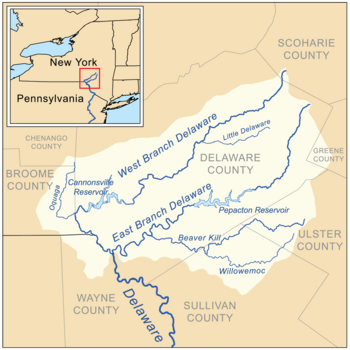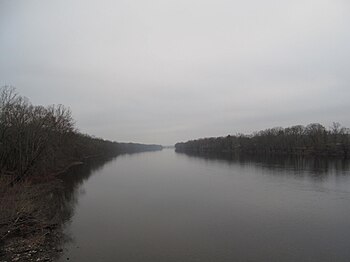Delaware River: Difference between revisions
Pat Palmer (talk | contribs) mNo edit summary |
mNo edit summary |
||
| (9 intermediate revisions by one other user not shown) | |||
| Line 1: | Line 1: | ||
{{subpages}} | {{subpages}} | ||
{{Image|Delaware headwaters map.png|right| | {{Image|Washington Crossing, Pennsylvania (8483462033).jpg|right|350px|A 2012 view of the Delaware River near the place where George Washington's troops crossed the ice-laden river on Christmas night of 1776, perhaps 100 miles upstream (north) of the point where the river broadens to become the Delaware Bay.}} | ||
{{Image|Delaware river watershed.png|right|350px|A map of the Delaware River watershed which reaches into four U.S. states.}} | |||
{{Image|Delaware headwaters map.png|right|350px|The Delaware River's headwaters are in [[New York (U.S. state)|New York state]] and northern Pennsylvania. It is a popular area for watching bald eagles in wintertime.}} | |||
The '''Delaware River''' is the longest free-flowing, undammed [[United States of America|U.S.]] river east of the [[Mississippi River]]. The river has tidal flows that end around [[Trenton, New Jersey]], and all 330 miles of the river act as an interstate boundary between [[Delaware (U.S. state)|Delaware]], [[Pennsylvania (U.S. state)|Pennsylvania]], [[New Jersey (U.S. state)|New Jersey]], and [[New York (U.S. state)|New York]]. Around 6.4 billion gallons of water are taken from the river basin daily, and it is used by over 14 million people as their primary source of water. | |||
The Delaware River provides drinking water to over 17 million people. Its watershed reaches into four states: New York, Pennsylvania, New Jersey and Delaware. In 1988, the non-profit Delaware Riverkeeper Network<ref name=DRKN /> was created to address issues of habitat pollution and restoration across the entire watershed, and to advocate for clear water policies nationwide. | |||
On March 24, 2023, there was a serious spillage of acrylic latex polymer into Otter Creek, leading to the Delaware River. The spill was from the Trinseo Altuglas facility in Bristol, PA, and released about 8100 gallons of the pollutant into the creek, and possibly as much as 12,000 gallons. The spill potentially impacted four drinking water systems on both the Pennsylvania and New Jersey sides of the river, as well as the natural environments attached to the river, Otter Creek, Mill Creek, and the Bristol Marsh. | |||
A lot more information about the Delaware River and its watershed is in Wikipedia's [[Wikipedia:Delaware River|Delaware River]] article. | |||
==Notes== | |||
<references> | |||
<ref name=DRKN> | |||
[https://www.delawareriverkeeper.org/ Delaware Riverkeeper Network], last access 5/31/2023. | |||
</ref> | |||
</references>[[Category:Suggestion Bot Tag]] | |||
Latest revision as of 16:01, 5 August 2024

The Delaware River is the longest free-flowing, undammed U.S. river east of the Mississippi River. The river has tidal flows that end around Trenton, New Jersey, and all 330 miles of the river act as an interstate boundary between Delaware, Pennsylvania, New Jersey, and New York. Around 6.4 billion gallons of water are taken from the river basin daily, and it is used by over 14 million people as their primary source of water.
The Delaware River provides drinking water to over 17 million people. Its watershed reaches into four states: New York, Pennsylvania, New Jersey and Delaware. In 1988, the non-profit Delaware Riverkeeper Network[1] was created to address issues of habitat pollution and restoration across the entire watershed, and to advocate for clear water policies nationwide.
On March 24, 2023, there was a serious spillage of acrylic latex polymer into Otter Creek, leading to the Delaware River. The spill was from the Trinseo Altuglas facility in Bristol, PA, and released about 8100 gallons of the pollutant into the creek, and possibly as much as 12,000 gallons. The spill potentially impacted four drinking water systems on both the Pennsylvania and New Jersey sides of the river, as well as the natural environments attached to the river, Otter Creek, Mill Creek, and the Bristol Marsh.
A lot more information about the Delaware River and its watershed is in Wikipedia's Delaware River article.
Notes
- ↑ Delaware Riverkeeper Network, last access 5/31/2023.

